
Leptospermum recurvum is a species of shrub or tree that is endemic to Mount Kinabalu in Malaysian Borneo. It has pale, flaky bark, broadly elliptical to almost round leaves, white flowers about 12 mm (0.47 in) wide and fruit that tend to remain on the plant for a year or two.
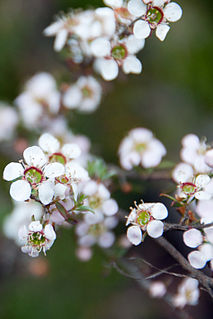
Leptospermum myrsinoides, commonly known as the heath tea-tree or silky tea-tree, is a species of shrub that is endemic to south-eastern continental Australia. It has smooth bark on the younger stems, narrow egg-shaped leaves with the narrower end towards the base, white flowers and fruit that has the remains of the sepals attached but usually falls from the plant soon after the seeds are released.

Leptospermum jingera, commonly known as the stringybark tea-tree, is a species of shrub that is endemic to Victoria, Australia. It has papery bark on the larger branches, smooth bark on the younger stems, narrow egg-shaped to elliptical leaves, white flowers and silky-hairy, hemispherical fruit.
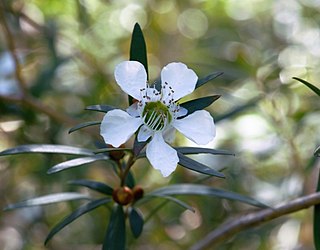
Leptospermum morrisonii is a shrub or small tree that is endemic to New South Wales. It has strongly aromatic, elliptical to lance-shaped or curved leaves, white or greenish white flowers and fruit that remain on the plant. It occurs in the south-east of the state.

Leptospermum inelegans is a species of straggly shrub that is endemic to Western Australia. It has only partly hairy young stems, egg-shaped to narrow elliptical leaves on a short petiole, relatively small white or pink flowers and fruit that fall from the plant when mature.

Leptospermum multicaule, commonly known as the silver tea-tree, is a species of shrub that is endemic to south eastern Australia. It has linear, narrow elliptical or narrow egg-shaped leaves, white or pink flowers usually borne singly on short side shoots, and fruit the falls from the plant soon after the seeds are released.
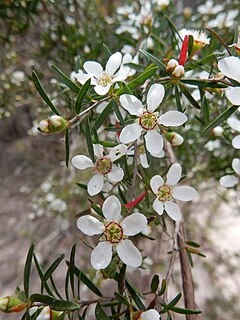
Leptospermum deanei, commonly known as Deane's tea-tree, is a species of rare, slender shrub that is endemic to the northern suburbs of Sydney. It has bark peeling in long strips from the older stems, hairy young stems, narrow elliptical to lance-shaped leaves, white flowers arranged singly on short side shoots and mostly glabrous fruit.
Leptospermum benwellii is a species of shrub that is endemic to the Nymboida National Park in New South Wales. It has smooth bark, young branches with conspicuous flanges, narrow elliptical leaves, white flowers and thin-walled, bell-shaped to hemispherical fruit.

Leptospermum blakelyi is a species of shrub that is endemic to rocky clifftops near Lithgow in New South Wales. It has densely silky young stems, egg-shaped to elliptical leaves and white or pink flowers.

Leptospermum brevipes, commonly known as the slender tea-tree, is a species of shrub or small tree that is endemic to eastern Australia. It has fibrous bark on the main stems, smooth bark on young stems, narrow elliptical to narrow egg-shaped leaves, white flowers and hemispherical fruit that is shed when mature.
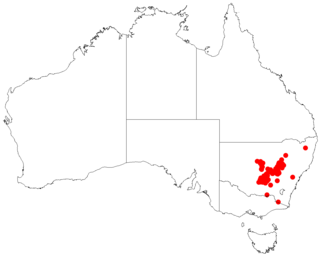
Leptospermum divaricatum is a species of plant that is endemic to inland New South Wales. It is an erect or weeping shrub with compact fibrous bark, elliptical to egg-shaped leaves, white flowers arranged singly on short axillary side shoots and woody fruit that fall off when mature.
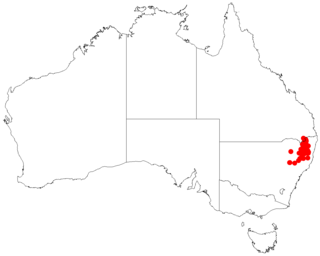
Leptospermum gregarium is a species of shrub that is endemic to eastern Australia. Its young stems are hairy the leaves are egg-shaped to lance-shaped with the narrower end towards the base, the flowers are white and arranged singly or in pairs on short side branches and the fruit remain on the plant at maturity. It usually grows in dense stands in swamps or along rocky creeks in high altitude place in northern New South Wales and south-eastern Queensland.
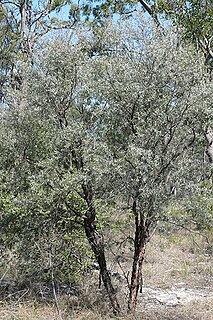
Leptospermum lamellatum is a species of shrub or small tree that is endemic to inland Queensland and has distinctive reddish, layered bark. It has narrow elliptical leaves, white flowers and small fruit that fall from the plant when mature.

Leptospermum myrtifolium, commonly known as the myrtle tea-tree or grey tea-tree, is a species of shrub that is endemic to south eastern Australia. It has broad egg-shaped to elliptical leaves, white flowers usually borne singly on short side shoots, and fruit that remains on the plant until it dies.
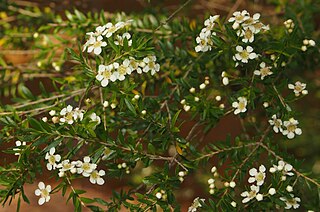
Leptospermum neglectum is a shrub or small tree that is endemic to Queensland. It has elliptical leaves that are silky-hairy at first, white flowers on short shoots in leaf axils and fruit with the remnants of the sepals attached but that fall from the plant shortly after the seeds are released.

Leptospermum novae-angliae is a species of shrub that is endemic to eastern Australia. It has elliptical leaves that are usually crowded, single white flowers on short shoots and fruit that remain on the plant until it dies. It usually grows in rocky places.
Leptospermum oreophilum, commonly known as the rock tea tree, is a shrub that is endemic to the Glass House Mountains in southern Queensland. It has firm, rough bark on the older stems, elliptical leaves with a short, blunt point on the tip, relatively large white flowers arranged singly on side shoots and fruit that remains on the plant until it dies.
Leptospermum polyanthum is a rigid, spreading shrub or small tree that is endemic to New South Wales. It has thin, rough bark, young stems that are hairy at first, elliptical leaves, relatively small white flowers and fruit are shed when the seeds are mature.

Leptospermum semibaccatum is a species of low, dense shrub that is endemic to eastern Australia. It has egg-shaped to narrow elliptical leaves with a blunt tip, white or pink flowers and hairy, flat-topped fruit that falls from the plant shortly after the seeds are released. It grows in poorly-drained soil in coastal heath.

Leptospermum sericatum is a species of erect shrub that is endemic to Queensland. It has thin, firm bark, narrow egg-shaped to elliptical leaves, white or pink flowers arranged usually singly on side shoots and fruit that falls from the plant when the seeds are released.

















